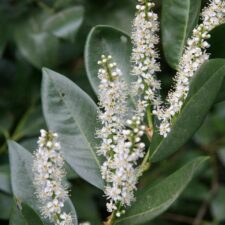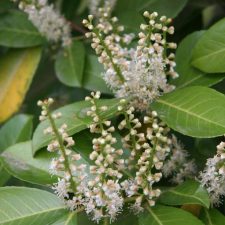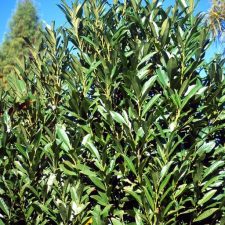Cherry Laurel (Prunus laurocerasus)

Photo credit: John Ruter, University of Georgia, Bugwood.org
Management Strategy
Squamish
Whistler
Pemberton
Vectors of Spread
ID Characteristics
General: Cherry laurel is a dark green shrub, widely used as an ornamental hedge plant.
Flowers: Tiny, very fragrant white flowers that form in upright, tube-shaped clusters.
Stem: Are green near newer leaves, and become brown and woody further down the plant. Cherry laurel is a broad, dense, spreading, evergreen shrub that can reach 3 – 5 m tall and 6 – 7 m wide.
Leaves: Dark and waxy evergreen leaves. Cherry laurel leaves are finely-toothed with an oblong shape, 5 – 18 cm long. The leaves grow in an alternating pattern along the stem, sprouting from a short stalk.
Fruits: Flowers mature into purple or black drupes with a large stone, which ripen in mid-summer. They are bitter and essentially inedible for humans, but consumed by birds and other animals.
Similar Species
Invasive
Spurge laurel (Daphne laureola): From the same genus as the cherry laurel, spurge laurel grows rapidly, out-competes native vegetation, and poses a serious health risk to people and pets for its poisonous sap. It can be distinguished by its strongly fragrant yellow-green flowers and leaves in a whorl formation.
Habitat and Origin
Origin: Originally native to southwestern Asia and southeastern Europe, cherry laurel is now widely used as an ornamental hedge in North America.
Habitat: Cherry laurel will grow in full sun or partial shade. It prefers moist, rich, and well-drained soils, and will tolerate salt spray. As a garden escapee, cherry laurel is typically found near residential areas.
How it Spreads
Cherry laurel reproduces by seeds; it can also reproduce vegetatively by creating new shoots from cut stems and roots, or by growing roots where the stems touch the ground.
Cherry laurel primarily spreads through its seeds, which are dispersed by birds and animals that eat them. The horticulture trade is another prevalent vector of spread for cherry laurel, as the plant is often used ornamentally. Lastly, cultivation stimulates new growth, so gardeners may inadvertently be spreading the plant in their efforts to work the soil.
Impacts
Health:
- Berries, leaves and bark are poisonous to humans
Ecological:
- Reduces biodiversity
- Outcompetes native forest species
- Could potentially crossbreed (hybridization)
Economical:
- Large thickets can become a nuisance for landowners and often require significant maintenance or removal
Stop the Spread
There is insufficient information about cherry laurel’s distribution, impacts, potential for spread and feasibility for control in the Sea to Sky. If you see cherry laurel, please report it.
Learn to identify cherry laurel: use the images presented in this profile page to learn how to identify this plant.
What to do if you spot it: You can report any sighting by clicking here.
DO:
- Regularly monitor properties for infestations.
- Be PlantWise: choose alternative, non-invasive plants for garden hedges.
- Ensure soil and gravel are uncontaminated before transport.
- Ensure plants (particularly flowering heads or root fragments) are bagged or covered to prevent spread during transport to designated disposal sites (e.g. landfill).
DO NOT:
- Don’t unload, park, or store equipment or vehicles in infested areas; remove plant material from any equipment, vehicles, or clothing used in such areas, and wash equipment and vehicles before leaving infested areas.
- Do not plant cherry laurel, no matter how well-contained the area might seem.
- DO NOT COMPOST!
Control
Mechanical
- Clip the plant before it flowers, or remove all the spent flowers before they can form fruit.
- Smaller plants can be dug up, taking care to remove all roots.
- Larger plants can be cut as close to the ground as possible (by hand or chainsaw), and then stumps can be dug out, or chemical control options used. Any cuttings should be bagged and disposed of in the garbage.
- Monitor any remaining stump for re-growth.
Chemical
- After removing branches and exposing the stump, the remaining plant can immediately be sprayed with glyphosate or triclopyr.
- Alternatively, the stump can be treated by frilling (chipping notches around the trunk and applying herbicide to the fresh cuts), or injecting herbicide directing into the trunk (using specialized injection tools).
- These methods can be used on large stems that have not been cut down, although it may be easier to first cut off smaller side stems and foliage to access the main trunk.
- We recommend that any herbicide application is carried out by a person holding a valid BC Pesticide Applicator Certificate. Before selecting and applying herbicides, you must review and follow herbicide labels and application rates; municipal, regional, provincial and federal laws and regulations; species-specific treatment recommendations, and site-specific goals and objectives.
Biological
- There is no biocontrol available for this plant in BC.
Sea to Sky Distribution
Cherry Laurel Factsheet
Having trouble viewing the factsheet? Don’t worry, all the information is included on this page. You can also contact us with any questions.
Additional Resources
References
- Electronic Atlas of the Flora of British Columbia, Prunus laurocerasus
- Evergreen, Invasive Plant Profile: Cherry-laurel, English-laurel
- Invasive Species Compendium, Prunus laurocerasus
- Invasive Species Council Metro Vancouver – Best Management Practices
- Invasive Species Council Metro Vancouver – Factsheet
- Invasive Species Ireland, Rhododendron and Cherry Laurel
- King County, Cherry laurel identification and control
- Missouri Botanical Garden, Prunus laurocerasus ‘Otto Luyken’
- Stanley Park Ecology Society, Invasive Plant Management Plan
- Vancouver Island Grows, Prunus laurocerasus
- West Vancouver, Best management practices and target plant profiles – Except from Invasive Plant Strategy, June 2014















